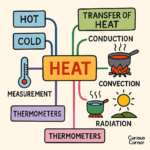📘 Class 7 Heat Chapter: Key Concepts Every Student Must Know 🔥 (CBSE 2025)
👋 Still confused about heat transfer, conduction, and thermometers?
Here’s your ultimate guide to the Class 7 NCERT Science Chapter – Heat. Perfect for quick revision, CBSE exam prep, or classroom reference. ✅
🟠 Chapter: Heat – Class 7 Science
Understanding heat and how it moves is the foundation of thermal science. This chapter helps you master temperature, thermometers, and everyday heat-related phenomena.
🔥 1. What is Heat?
- Heat is a form of energy that makes things hot or cold.
- It always flows from a hotter object to a colder object.
🌡️ 2. Hot and Cold
While our skin can sense hot or cold, it’s not accurate.
✔️ Thermometers are used to measure temperature precisely.
🧪 3. What is Temperature?
- Temperature tells us how hot or cold something is.
- Measured in:
- Degrees Celsius (°C)
- Degrees Fahrenheit (°F)
🎯 Normal body temperature:
37°C or 98.6°F
🧴 4. Thermometers: Types & Uses
| Thermometer Type | Use | Temperature Range |
|---|---|---|
| Clinical Thermometer | Measures human body temperature | 35°C to 42°C |
| Laboratory Thermometer | Used in labs & experiments | –10°C to 110°C |
✅ Clinical thermometer has a kink to prevent mercury from falling back.
❌ Lab thermometers don’t have this and aren’t used on humans.
🛣️ 5. How Does Heat Transfer?
Heat moves in three main ways:
| Mode of Transfer | Description | Real-life Example |
|---|---|---|
| Conduction | Heat transfer in solids by contact | Cooking in a metal pan |
| Convection | Heat transfer in liquids and gases | Boiling water, sea breeze |
| Radiation | Heat transfer without a medium | Sun heating the Earth |
🔩 6. Conductors and Insulators
| Type | What It Does | Examples |
|---|---|---|
| Conductors | Allow heat to pass through easily | Metals (iron, copper) |
| Insulators | Do not allow heat to pass easily | Wood, plastic, wool, air |
🌬️ 7. Sea Breeze & Land Breeze Explained
☀️ Day (Sea Breeze):
Land heats up → Hot air rises → Cool air from sea replaces it.
🌙 Night (Land Breeze):
Sea is warmer → Hot air over sea rises → Cool air from land moves in.
✅ This cycle creates coastal breezes daily.
🧥 8. Clothes & Seasonal Heat
- Winter: Woolen clothes trap air → keep us warm.
- Summer: Light-colored cotton clothes → reflect heat + absorb sweat.
🧠 Smart dressing = smart heat management!
What is Heat Transfer?
Heat transfer is the movement of thermal energy from a hotter body to a cooler one. It occurs through:
✅ Conduction
✅ Convection
✅ Radiation
📘 Modes of Heat Transfer – Overview
| Mode | Medium Required? | How It Works | Example |
|---|---|---|---|
| Conduction | ✅ Yes (Solids) | Direct contact; particle to particle | Metal spoon in hot tea |
| Convection | ✅ Yes (Liquids/Gases) | Movement of particles in fluids | Boiling water |
| Radiation | ❌ No | Heat transfer through waves | Sun warming Earth |
🧊 1. Conduction – Heat Through Solids
Definition:
Transfer of heat within solids by direct contact.
Best in: Metals
Bad in: Wood, plastic, rubber (called insulators)
Example:
When you heat one end of an iron rod, the other end becomes hot.
📊 Conductors vs Insulators
| Good Conductors | Poor Conductors (Insulators) |
|---|---|
| Copper, Iron | Wood, Plastic, Cloth |
🌊 2. Convection – Heat Through Liquids & Gases
Definition:
Transfer of heat in fluids (liquids and gases) through movement of particles.
Example:
Boiling water or warm air rising up
Natural Examples:
-
Sea breeze and land breeze
-
Geysers and hot springs
☀️ 3. Radiation – Heat Without Medium
Definition:
Heat transfer that doesn’t need any medium, carried by infrared rays.
Example:
Sunlight reaching Earth.
Feeling warm from a heater even from a distance.
🔁 Summary : Heat Transfer Comparison
| Feature | Conduction | Convection | Radiation |
|---|---|---|---|
| Medium Needed | Solid | Liquid/Gas | Not required |
| Transfer Type | Contact | Particle movement | Waves (infrared) |
| Speed | Slow | Moderate | Fast |
| Real Example | Hot spoon | Boiling soup | Sunlight |
🧠 Quick Revision Tricks
-
Conduction = Contact (solid to solid)
-
Convection = Currents (in liquids/gases)
-
Radiation = Rays (through vacuum)
📝 Practice Questions
-
Why does a metal pan handle feel hot?
👉 Due to conduction of heat through metal. -
How does heat reach you from a bonfire?
👉 Through radiation. -
Why does water boil from the bottom up?
👉 Because of convection currents.
📣 Final Tip for CBSE Students
Mastering the three modes of heat transfer helps not only in exams but also in understanding daily life examples like cooking, weather, and climate! ✅
📝 Key Terms Recap
- Heat – Energy that moves from hot to cold.
- Temperature – Measures how hot/cold something is.
- Conduction – Transfer in solids.
- Convection – Transfer in liquids/gases.
- Radiation – Transfer without contact.
- Conductor – Allows heat.
- Insulator – Blocks heat.
💡 Quick Science Tip
- Mercury is used in thermometers because it expands uniformly and is visible.
- Never use a clinical thermometer for lab experiments — it’s not designed for that!
📥 FREE Resources for You!


Pingback: Some Mountains Have No Snow?! 🌄 Discover the Fascinating Truth Behind It ❄️